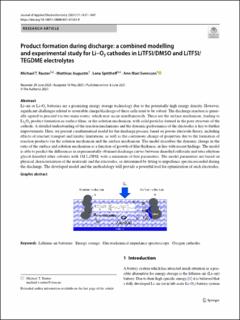| dc.contributor.author | Rauter, Michael Tobias | |
| dc.contributor.author | Augustin, Matthias | |
| dc.contributor.author | Spitthoff, Lena | |
| dc.contributor.author | Svensson, Ann Mari | |
| dc.date.accessioned | 2021-11-03T09:24:10Z | |
| dc.date.available | 2021-11-03T09:24:10Z | |
| dc.date.created | 2021-08-17T15:40:53Z | |
| dc.date.issued | 2021 | |
| dc.identifier.citation | Journal of Applied Electrochemistry. 2021, . | en_US |
| dc.identifier.issn | 0021-891X | |
| dc.identifier.uri | https://hdl.handle.net/11250/2827511 | |
| dc.description.abstract | Li–air or Li–O2 batteries are a promising energy storage technology due to the potentially high energy density. However, significant challenges related to reversible charge/discharge of these cells need to be solved. The discharge reaction is generally agreed to proceed via two main routes, which may occur simultaneously. These are the surface mechanism, leading to Li2O2 product formation as surface films, or the solution mechanism, with solid particles formed in the pore structure of the cathode. A detailed understanding of the reaction mechanisms and the dynamic performance of the electrodes is key to further improvements. Here, we present a mathematical model for the discharge process, based on porous electrode theory, including effects of reactant transport and kinetic limitations, as well as the continuous change of properties due to the formation of reaction products via the solution mechanism and the surface mechanism. The model describes the dynamic change in the ratio of the surface and solution mechanism as a function of growth of film thickness, in line with recent findings. The model is able to predict the differences in experimentally obtained discharge curves between dimethyl sulfoxide and tetra ethylene glycol dimethyl ether solvents with 1M LiTFSI, with a minimum of free parameters. The model parameters are based on physical characterization of the materials and the electrodes, or determined by fitting to impedance spectra recorded during the discharge. The developed model and the methodology will provide a powerful tool for optimization of such electrodes. | en_US |
| dc.language.iso | eng | en_US |
| dc.publisher | Springer | en_US |
| dc.rights | Navngivelse 4.0 Internasjonal | * |
| dc.rights.uri | http://creativecommons.org/licenses/by/4.0/deed.no | * |
| dc.title | Product formation during discharge: a combined modelling and experimental study for Li–O2 cathodes in LiTFSI/DMSO and LiTFSI/TEGDME electrolytes | en_US |
| dc.type | Peer reviewed | en_US |
| dc.type | Journal article | en_US |
| dc.description.version | publishedVersion | en_US |
| dc.source.pagenumber | 11 | en_US |
| dc.source.journal | Journal of Applied Electrochemistry | en_US |
| dc.identifier.doi | 10.1007/s10800-021-01583-9 | |
| dc.identifier.cristin | 1926702 | |
| cristin.ispublished | true | |
| cristin.qualitycode | 1 | |

